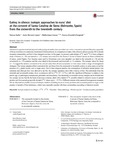Eating in silence: isotopic approaches to nuns' diet at the convent of Santa Catalina de Siena (Belmonte, Spain) from the sixteenth to the twentieth century

Use this link to cite
http://hdl.handle.net/2183/23943Collections
- IUX-CULXEO - Artigos [65]
Metadata
Show full item recordTitle
Eating in silence: isotopic approaches to nuns' diet at the convent of Santa Catalina de Siena (Belmonte, Spain) from the sixteenth to the twentieth centuryDate
2019-08Citation
Sarkic, N., López, J.H., López-Costas, O. et al. Archaeol Anthropol Sci (2019) 11: 3895. https://doi.org/10.1007/s12520-018-0734-3
Abstract
[Abstract] Advances in geochemical and physical anthropological studies have provided new tools to reconstruct ancient lifestyles, especially of those minorities not commonly mentioned in historical texts. In comparison to males, little is known about everyday life in female monastic communities, and how it has changed over time. In this paper, we present a paleodietary (δ13C and δ15N in bone collagen) study of human (n = 58) and animal (n = 13) remains recovered from the former Convent of Santa Catalina de Siena in Belmonte (Cuenca, central Spain). Two funerary areas used by Dominican nuns were sampled: one dated to the sixteenth (n = 34) and the seventeenth (n = 15) centuries, and the other dated in the nineteenth and twentieth (n = 9) centuries. The isotopic values for sheep (n = 7) suggest the animals consumed at the convent came from diverse ecosystems or were raised under a range of management strategies. The human samples reflect a terrestrial diet, and those from the nineteenth to twentieth century, in some cases, reveal the presence of C4 plants (millet, corn or sugar cane). Due to their religious practice, the consumption of terrestrial animal protein was restricted, and although they were allowed to eat fish, the isotopic signatures show little evidence of this. The individuals from the sixteenth and seventeenth century show a continuous shift in δ15N (9.7–12.7‰), with few significant differences in relation to the period, age, or pathologies (osteoporosis, periostitis, and brucellosis). The nineteenth- to twentieth-century samples can be divided into two groups: (a) one that fits the trend of previous centuries, albeit with a higher δ15N, possibly related to extensive access to animal protein; and (b) a second group with elevated δ13C values (up to − 15.7‰). Different customs in the assumed homogeneous monastic life are discussed as possible sources of isotopic variation, including access to luxury products such as animal protein or sugar, or the practice of periods of food abstinence, which were especially popular with these communities, according to historical records.
Keywords
Isotopic analysis in collagen
δ13C
δ15N
Paleodiet
Paleopathology
Modern period
Female monastic population
δ13C
δ15N
Paleodiet
Paleopathology
Modern period
Female monastic population
Editor version
Rights
Atribución 3.0 España
ISSN
1866-9557
1866-9565
1866-9565






